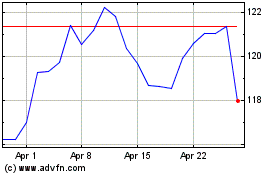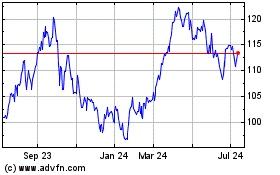By Selina Williams and Bradley Olson
Some of the world's largest energy companies are saddled with
their highest debt levels ever as they struggle with low crude
prices, raising worries about their ability to pay dividends and
find new barrels.
Exxon Mobil Corp., Royal Dutch Shell PLC, BP PLC and Chevron
Corp. hold a combined net debt of $184 billion -- more than double
their debt levels in 2014, when oil prices began a steep descent
that eventually bottomed out at $27 a barrel earlier this year.
Crude prices have rebounded since, but still hover near $50 a
barrel.
The soaring debt levels are a fresh reminder of the toll the
two-year price slump has taken on the oil industry. Just a decade
ago, these four companies were hauled before Congress to explain
"windfall profits" but now can't cover expenses with normal cash
flow.
Executives at BP, Shell, Exxon and Chevron have assured
investors that they will generate enough cash in 2017 to pay for
new investments and dividends, but some shareholders are skeptical.
In the first half of 2015, the companies fell short of that goal by
$40 billion, according to a Wall Street Journal analysis of their
numbers.
"Eventually something will give," said Michael Hulme, manager of
the $550 million Carmignac Commodities Fund, which holds stakes in
Shell and Exxon. "These companies won't be able to maintain the
current dividends at $50 to $60 oil -- it's unsustainable."
The debt is piling up despite cuts of billions of dollars on new
projects and current operations. Repaying the loans could weigh the
companies down for years, crimping their ability to make
investments elsewhere and keep pumping ever more oil and gas.
The companies spent more than 100% of their profits on dividends
last year. This year, the problem got worse. In the April-to-June
period, Exxon paid $3.1 billion in dividends and had just $1.7
billion in net income, according to S&P Global Market
Intelligence. Shell paid $1.26 billion in interest in the first
half of 2016, compared with $726 million in the same period a year
earlier.
"They are just not spending enough to boost production," said
Jonathan Waghorn, co-portfolio manager in London at Guinness
Atkinson Asset Management Inc. who helps oversee more than $400
million across a range of energy funds, including shares in Exxon,
BP, Chevron and Shell.
The oil companies say they have many tools to deploy to help
defray debt, including selling assets and offering shareholders
more shares instead of a cash dividend, as well as continuing to
cut costs. Record-low interest rates are helping ease some of the
pain.
They also say the steep levels of debt are temporary as the
companies restructure, and the debt will fall when oil prices
rise.
"We are in a transitional stage in 2016," said Shell Chief
Executive Ben van Beurden during last month's earnings disclosures.
The company reported a rise in net debt to over $75 billion at the
end of the second quarter, in large part because of its acquisition
of BG Group PLC.
BP has said it expects to be able to pay for its operations,
make new investments and meet its dividend at an oil price of
between $50 and $55 a barrel next year.
But analysts and investors say the oil slump is making it harder
than ever for companies to raise money with asset sales to pay off
debt. Handing out more shares to shareholders is only storing up
the dividend problem for the future when the companies will need to
pay up. Even the boost many companies got from bumper profits from
their refining divisions -- which tend to do well when prices are
low -- looks to be coming to an end as a glut of gasoline erodes
fuel prices, say investors and analysts.
Still, some funds see BP, Shell Exxon and Chevron as big enough
to weather problems for the next year and a half. Wilmington Trust
has reduced its exposure to energy companies it deems more risky in
favor of other corporate debt. But the firm remains invested in
debt issued by BP, Chevron and Shell
"They're so big, they can diversity, they have more levers to
push and pull in terms of shoring up their creditworthiness," said
Wilmer Stith, senior fixed-income portfolio manager at Wilmington
Trust, which has $73 billion in assets under management.
Only another long period of oil below $40 a barrel would pose a
challenge that could prompt dividend cuts, said Iain Reid, senior
oil analyst at Macquarie Capital. A Goldman Sachs report this week
projected oil prices remaining between $45 and $50 a barrel for
much of the next year.
"The question is, can they get through this year and next
without doing something radical like cutting dividends?" said Iain
Reid, senior oil analyst at Macquarie Capital.
The rise in net debt has helped push these companies' ratio of
net debt to equity to the highest level in years, which influences
the ratings given by credit agencies. S&P has already
downgraded Shell, Chevron, Exxon and BP, though they all remain
highly rated.
Shell's debt-to-equity ratio is at 28% and Chief Financial
Officer Simon Henry said last month it could even reach its
targeted maximum of 30%. BP's gearing is over 25%, while Chevron's
is 20% and Exxon's is around 18%.
By comparison, in 2012, Shell's gearing was around 10%, and
Exxon's was 1.2%. Back in 2005, when oil prices were climbing
steadily, Exxon had no debt, and its profits were so high that its
executives and those from other big oil companies were called to
testify in front of the U.S. Senate about their so-called windfall
profits.
Chevron's Chief Financial Officer Patricia Yarrington said in
April that the company's higher levels of debt were expected. "We
could handle that if it's temporary," she said.
Much of the new debt has been in corporate bonds. Exxon, for
instance, issued $12 billion in debt in February. Two months later,
the company was downgraded by S&P Global Ratings, losing the
triple-A credit rating that it had held since 1930.
Exxon Chief Executive Rex Tillerson has assured investors that
Exxon remains committed to paying its dividend.
The company has increased shareholder payments for 34 straight
years, although those increases have been modest in the past two
years. Mr. Tillerson and others have noted that Exxon has the
ability to borrow further. If anything, the company has signaled a
willingness to go further into debt for strategic opportunities,
such as buying assets, including InterOil Corp., a small company
focused on gas exports in Papua New Guinea that Exxon agreed to
acquire for an estimated $2.5 billion in July
"We're not going to forgo attractive opportunities," said Jeff
Woodbury, Exxon's vice president of investor relations, on an
investor call last month.
--Heather Gillers in New York contributed to this article.
Write to Selina Williams at selina.williams@wsj.com and Bradley
Olson at Bradley.Olson@wsj.com
(END) Dow Jones Newswires
August 24, 2016 16:57 ET (20:57 GMT)
Copyright (c) 2016 Dow Jones & Company, Inc.
Exxon Mobil (NYSE:XOM)
Historical Stock Chart
From Mar 2024 to Apr 2024

Exxon Mobil (NYSE:XOM)
Historical Stock Chart
From Apr 2023 to Apr 2024
